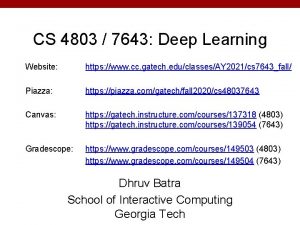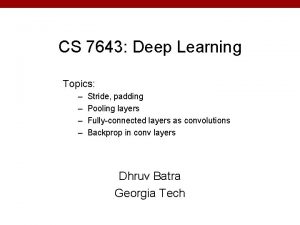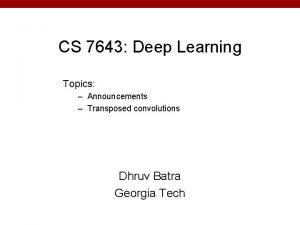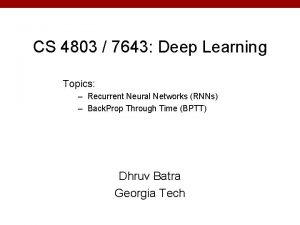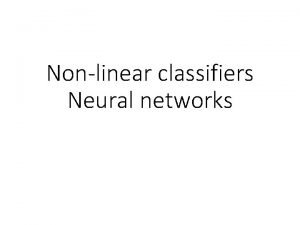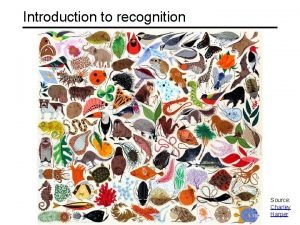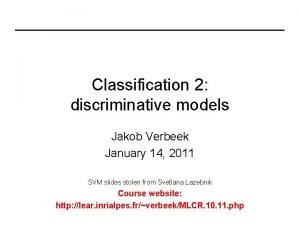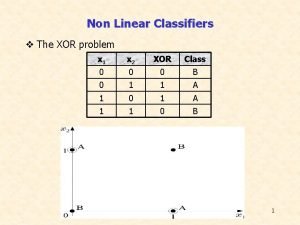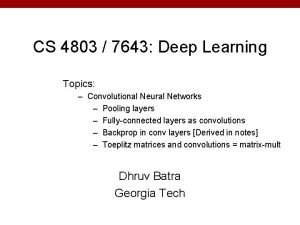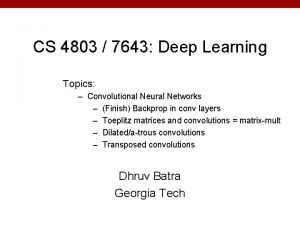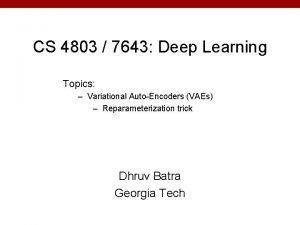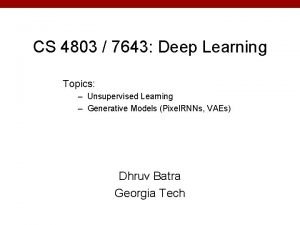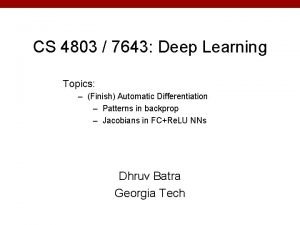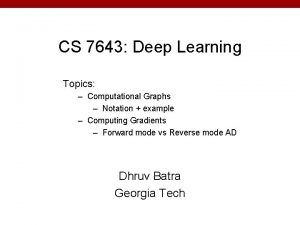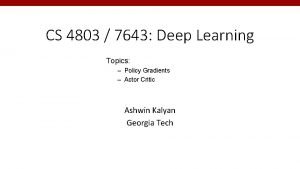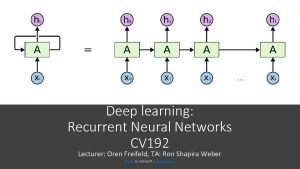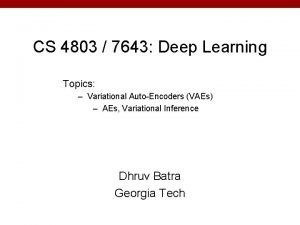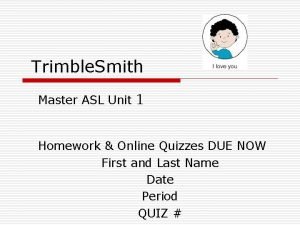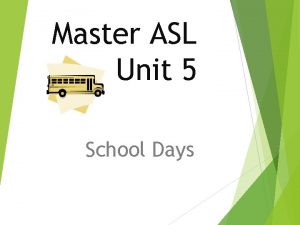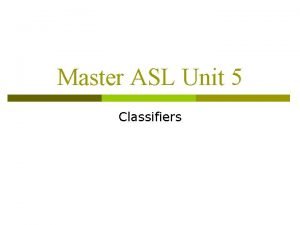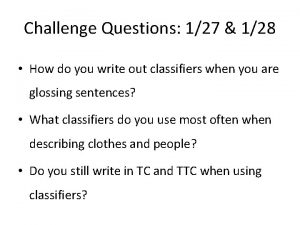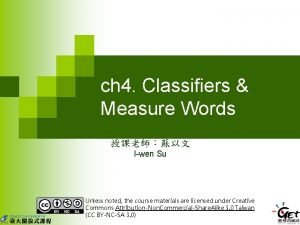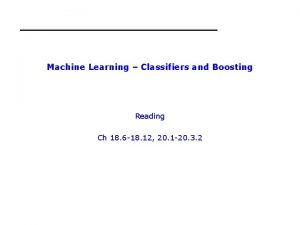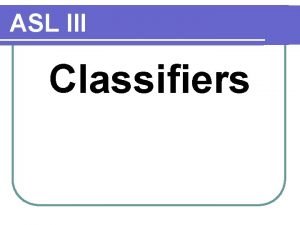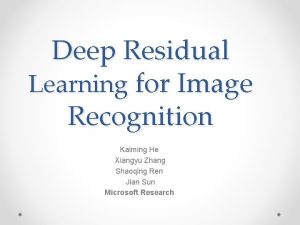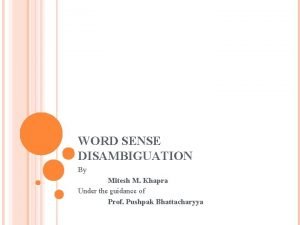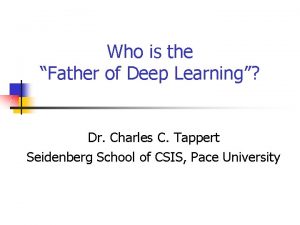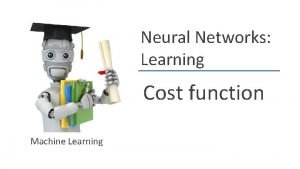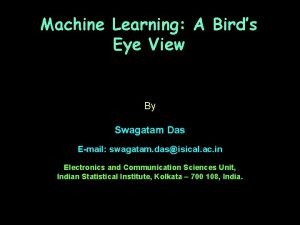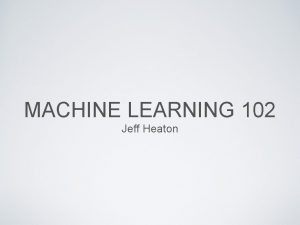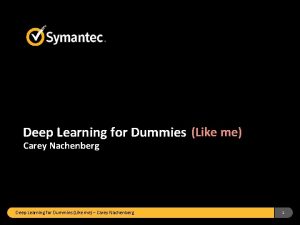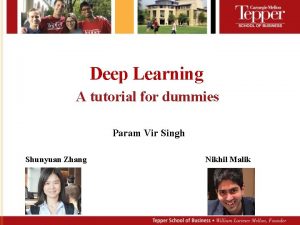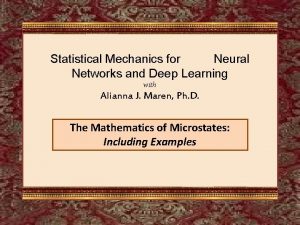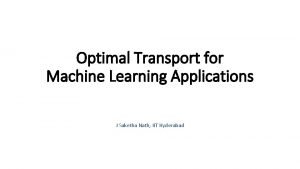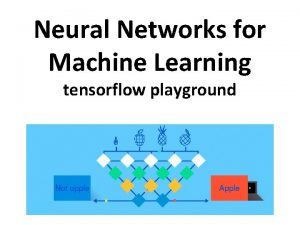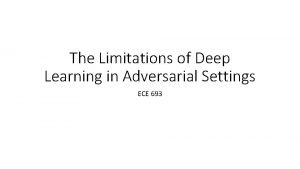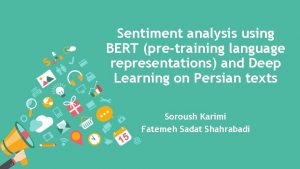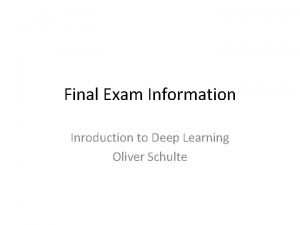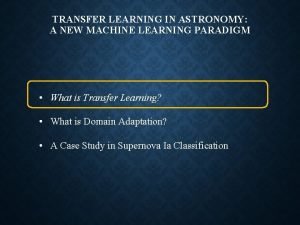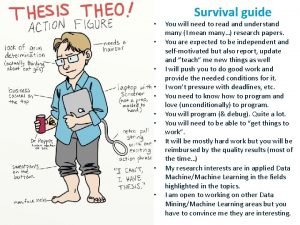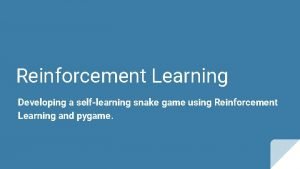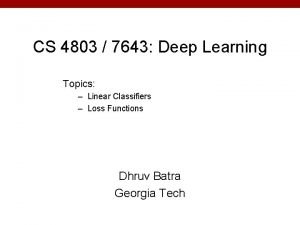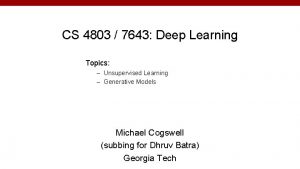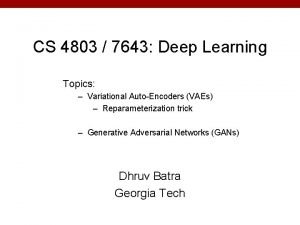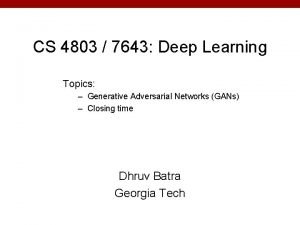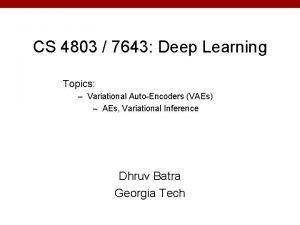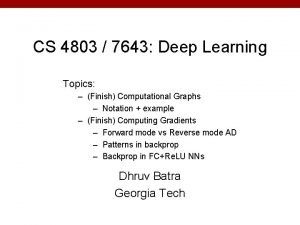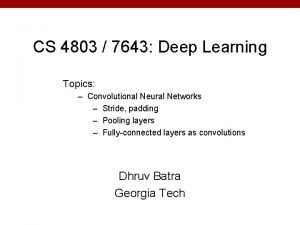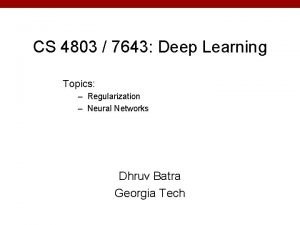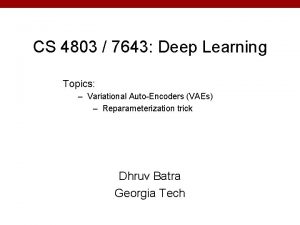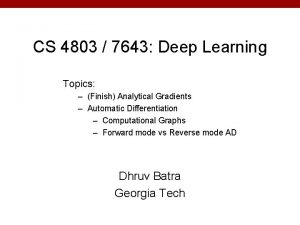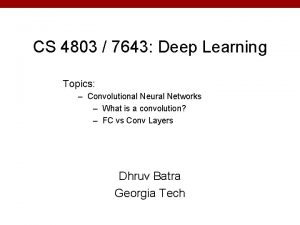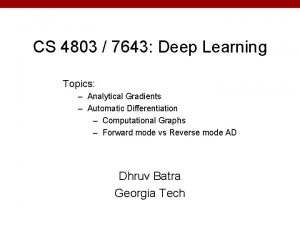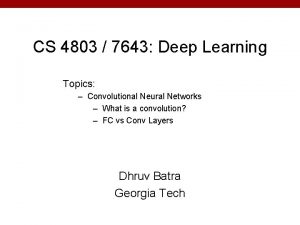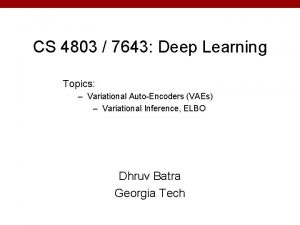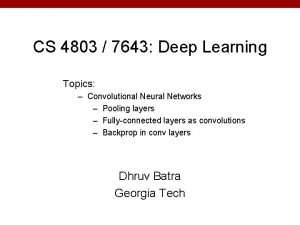CS 4803 7643 Deep Learning Topics Linear Classifiers














































































- Slides: 78

CS 4803 / 7643: Deep Learning Topics: – Linear Classifiers – Loss Functions Dhruv Batra Georgia Tech

Administrativia • Notes and readings on class webpage – https: //www. cc. gatech. edu/classes/AY 2020/cs 7643_fall/ • HW 0 solutions and grades released • Issues from PS 0 submission – Instructions not followed = not graded (C) Dhruv Batra 2

Recap from last time (C) Dhruv Batra 3

Image Classification: A core task in Computer Vision (assume given set of discrete labels) {dog, cat, truck, plane, . . . } cat This image by Nikita is licensed under CC-BY 2. 0 Slide Credit: Fei-Fei Li, Justin Johnson, Serena Yeung, CS 231 n

An image classifier Unlike e. g. sorting a list of numbers, no obvious way to hard-code the algorithm for recognizing a cat, or other classes. 5 Slide Credit: Fei-Fei Li, Justin Johnson, Serena Yeung, CS 231 n

Supervised Learning • Input: x • Output: y (images, text, emails…) (spam or non-spam…) • (Unknown) Target Function – f: X Y (the “true” mapping / reality) • Data – { (x 1, y 1), (x 2, y 2), …, (x. N, y. N) } • Model / Hypothesis Class – H = {h: X Y} – e. g. y = h(x) = sign(w. Tx) • Loss Function – How good is a model wrt my data D? • Learning = Search in hypothesis space – Find best h in model class. (C) Dhruv Batra 6

Error Decomposition Alex. Net Reality Softmax FC 1000 r FC 4096 g lin e od Pool 3 x 3 conv, 256 3 x 3 conv, 384 Pool model class ro Er M 3 x 3 conv, 384 Pool 5 x 5 conv, 256 11 x 11 conv, 96 Input n tio a tim r Es Erro Op tim Er izat ro ion r (C) Dhruv Batra 7

First classifier: Nearest Neighbor Memorize all data and labels Predict the label of the most similar training image 8 Slide Credit: Fei-Fei Li, Justin Johnson, Serena Yeung, CS 231 n

Nearest Neighbours

Instance/Memory-based Learning Four things make a memory based learner: • A distance metric • How many nearby neighbors to look at? • A weighting function (optional) • How to fit with the local points? (C) Dhruv Batra Slide Credit: Carlos Guestrin 10

Hyperparameters Your Dataset Idea #4: Cross-Validation: Split data into folds, try each fold as validation and average the results fold 1 fold 2 fold 3 fold 4 fold 5 test Useful for small datasets, but not used too frequently in deep learning 11 Slide Credit: Fei-Fei Li, Justin Johnson, Serena Yeung, CS 231 n

Problems with Instance-Based Learning • Expensive – No Learning: most real work done during testing – For every test sample, must search through all dataset – very slow! – Must use tricks like approximate nearest neighbour search • Doesn’t work well when large number of irrelevant features – Distances overwhelmed by noisy features • Curse of Dimensionality – Distances become meaningless in high dimensions – (See proof in next lecture) (C) Dhruv Batra 12

Plan for Today • Linear Classifiers – Linear scoring functions • Loss Functions – Multi-class hinge loss – Softmax cross-entropy loss (C) Dhruv Batra 13

Linear Classification

Neural Network Linear classifiers This image is CC 0 1. 0 public domain Slide Credit: Fei-Fei Li, Justin Johnson, Serena Yeung, CS 231 n

Visual Question Answering Image Embedding (VGGNet) 4096 -dim Convolution Layer + Non-Linearity Pooling Layer Neural Network Softmax over top K answers Fully-Connected MLP Question Embedding (LSTM) “How many horses (C) Dhruv Batra are in this image? ” 16

Recall CIFAR 10 50, 000 training images each image is 32 x 3 10, 000 test images. Slide Credit: Fei-Fei Li, Justin Johnson, Serena Yeung, CS 231 n

Parametric Approach Image f(x, W) Array of 32 x 3 numbers (3072 numbers total) 10 numbers giving class scores W parameters or weights Slide Credit: Fei-Fei Li, Justin Johnson, Serena Yeung, CS 231 n

Parametric Approach: Linear Classifier f(x, W) = Wx + b Image f(x, W) Array of 32 x 3 numbers (3072 numbers total) 10 numbers giving class scores W parameters or weights Slide Credit: Fei-Fei Li, Justin Johnson, Serena Yeung, CS 231 n

Parametric Approach: Linear Classifier 3072 x 1 f(x, W) = Wx + b Image 10 x 1 10 x 3072 f(x, W) Array of 32 x 3 numbers (3072 numbers total) 10 x 1 10 numbers giving class scores W parameters or weights Slide Credit: Fei-Fei Li, Justin Johnson, Serena Yeung, CS 231 n

Example with an image with 4 pixels, and 3 classes (cat/dog/ship) Stretch pixels into column 56 56 231 24 2 Input image 231 24 2 21 Slide Credit: Fei-Fei Li, Justin Johnson, Serena Yeung, CS 231 n

Example with an image with 4 pixels, and 3 classes (cat/dog/ship) Stretch pixels into column 56 56 231 24 2 Input image 0. 2 -0. 5 0. 1 2. 0 1. 1 231 1. 5 1. 3 2. 1 0. 0 24 0 0. 25 0. 2 W -0. 3 2 + -96. 8 Cat score 437. 9 Dog score -1. 2 61. 95 Ship score b s 3. 2 = 22 Slide Credit: Fei-Fei Li, Justin Johnson, Serena Yeung, CS 231 n

(C) Dhruv Batra Image Credit: Andrej Karpathy, CS 231 n 23

Error Decomposition Alex. Net Reality Softmax FC 1000 r FC 4096 g lin e od Pool 3 x 3 conv, 256 3 x 3 conv, 384 Pool model class ro Er M 3 x 3 conv, 384 Pool 5 x 5 conv, 256 11 x 11 conv, 96 Input n tio a tim r Es Erro Op tim Er izat ro ion r (C) Dhruv Batra 24

Error Decomposition Reality r ng eli d o Multi-class Logistic Regression ro Er M Softmax FC Hx. Wx 3 Input l cl (C) Dhruv Batra ass n tio iza 0 im r = pt O Erro mo de n tio a tim Es Error 25

Example with an image with 4 pixels, and 3 classes (cat/dog/ship) Algebraic Viewpoint f(x, W) = Wx + b 26 Slide Credit: Fei-Fei Li, Justin Johnson, Serena Yeung, CS 231 n

Example with an image with 4 pixels, and 3 classes (cat/dog/ship) Input image Algebraic Viewpoint f(x, W) = Wx + b 0. 2 -0. 5 1. 3 0 . 25 0. 1 2. 0 2. 1 0. 0 0. 2 -0. 3 W b Score 1. 1 3. 2 -1. 2 -96. 8 437. 9 61. 95 27 Slide Credit: Fei-Fei Li, Justin Johnson, Serena Yeung, CS 231 n

Interpreting a Linear Classifier 28 Slide Credit: Fei-Fei Li, Justin Johnson, Serena Yeung, CS 231 n

Interpreting a Linear Classifier: Visual Viewpoint 29 Slide Credit: Fei-Fei Li, Justin Johnson, Serena Yeung, CS 231 n

Interpreting a Linear Classifier: Geometric Viewpoint f(x, W) = Wx + b Array of 32 x 3 numbers (3072 numbers total) Plot created using Wolfram Cloud Cat image by Nikita is licensed under CC-BY 2. 0 30 Slide Credit: Fei-Fei Li, Justin Johnson, Serena Yeung, CS 231 n

Hard cases for a linear classifier Class 1: First and third quadrants Class 1: 1 <= L 2 norm <= 2 Class 1: Three modes Class 2: Second and fourth quadrants Class 2: Everything else 31 Slide Credit: Fei-Fei Li, Justin Johnson, Serena Yeung, CS 231 n

Linear Classifier: Three Viewpoints Algebraic Viewpoint f(x, W) = Wx + b Visual Viewpoint Geometric Viewpoint One template per class Hyperplanes cutting up space 32 Slide Credit: Fei-Fei Li, Justin Johnson, Serena Yeung, CS 231 n

So far: Defined a (linear) score function f(x, W) = Wx + b Example class scores for 3 images for some W: How can we tell whether this W is good or bad? Cat image by Nikita is licensed under CC-BY 2. 0; Car image is CC 0 1. 0 public domain; Frog image is in the public domain Slide Credit: Fei-Fei Li, Justin Johnson, Serena Yeung, CS 231 n

So far: Defined a (linear) score function TODO: 1. Define a loss function that quantifies our unhappiness with the scores across the training data. 2. Come up with a way of efficiently finding the parameters that minimize the loss function. (optimization) Cat image by Nikita is licensed under CC-BY 2. 0; Car image is CC 0 1. 0 public domain; Frog image is in the public domain Slide Credit: Fei-Fei Li, Justin Johnson, Serena Yeung, CS 231 n

Supervised Learning • Input: x • Output: y (images, text, emails…) (spam or non-spam…) • (Unknown) Target Function – f: X Y (the “true” mapping / reality) • Data – (x 1, y 1), (x 2, y 2), …, (x. N, y. N) • Model / Hypothesis Class – {h: X Y} – e. g. y = h(x) = sign(w. Tx) • Loss Function – How good is a model wrt my data D? • Learning = Search in hypothesis space – Find best h in model class. (C) Dhruv Batra 35

Loss Functions

Suppose: 3 training examples, 3 classes. With some W the scores are: cat car frog 3. 2 5. 1 -1. 7 1. 3 4. 9 2. 0 2. 2 2. 5 -3. 1 Slide Credit: Fei-Fei Li, Justin Johnson, Serena Yeung, CS 231 n

Suppose: 3 training examples, 3 classes. With some W the scores are: A loss function tells how good our current classifier is Given a dataset of examples Where cat car frog 3. 2 5. 1 -1. 7 1. 3 4. 9 2. 0 2. 2 2. 5 -3. 1 is image and is (integer) label Loss over the dataset is a sum of loss over examples: Slide Credit: Fei-Fei Li, Justin Johnson, Serena Yeung, CS 231 n

Suppose: 3 training examples, 3 classes. With some W the scores are: Multiclass SVM loss: Given an example where is the image and where is the (integer) label, and using the shorthand for the scores vector: cat car frog 3. 2 5. 1 -1. 7 1. 3 4. 9 2. 0 2. 2 2. 5 -3. 1 the SVM loss has the form: Slide Credit: Fei-Fei Li, Justin Johnson, Serena Yeung, CS 231 n

Suppose: 3 training examples, 3 classes. With some W the scores are: Multiclass SVM loss: Given an example where is the image and where is the (integer) label, and using the shorthand for the scores vector: cat car frog 3. 2 5. 1 -1. 7 1. 3 4. 9 2. 0 2. 2 2. 5 -3. 1 the SVM loss has the form: Slide Credit: Fei-Fei Li, Justin Johnson, Serena Yeung, CS 231 n

Suppose: 3 training examples, 3 classes. With some W the scores are: Multiclass SVM loss: Given an example where is the image and where is the (integer) label, and using the shorthand for the scores vector: cat car frog 3. 2 5. 1 -1. 7 1. 3 4. 9 2. 0 2. 2 2. 5 -3. 1 the SVM loss has the form: Slide Credit: Fei-Fei Li, Justin Johnson, Serena Yeung, CS 231 n

Suppose: 3 training examples, 3 classes. With some W the scores are: Multiclass SVM loss: Given an example “Hinge loss” where is the image and where is the (integer) label, and using the shorthand for the scores vector: cat car frog 3. 2 5. 1 -1. 7 1. 3 4. 9 2. 0 2. 2 2. 5 -3. 1 the SVM loss has the form: Slide Credit: Fei-Fei Li, Justin Johnson, Serena Yeung, CS 231 n

Suppose: 3 training examples, 3 classes. With some W the scores are: Multiclass SVM loss: Given an example “Hinge loss” where is the image and where is the (integer) label, and using the shorthand for the scores vector: cat car frog 3. 2 5. 1 -1. 7 1. 3 4. 9 2. 0 2. 2 2. 5 -3. 1 the SVM loss has the form: Slide Credit: Fei-Fei Li, Justin Johnson, Serena Yeung, CS 231 n

Suppose: 3 training examples, 3 classes. With some W the scores are: Multiclass SVM loss: Given an example where is the image and where is the (integer) label, and using the shorthand for the scores vector: cat car frog 3. 2 5. 1 -1. 7 1. 3 4. 9 2. 0 2. 2 2. 5 -3. 1 the SVM loss has the form: Slide Credit: Fei-Fei Li, Justin Johnson, Serena Yeung, CS 231 n

Suppose: 3 training examples, 3 classes. With some W the scores are: Multiclass SVM loss: Given an example where is the image and where is the (integer) label, and using the shorthand for the scores vector: cat car frog Losses: 3. 2 5. 1 -1. 7 2. 9 1. 3 4. 9 2. 0 2. 2 2. 5 -3. 1 the SVM loss has the form: = max(0, 5. 1 - 3. 2 + 1) +max(0, -1. 7 - 3. 2 + 1) = max(0, 2. 9) + max(0, -3. 9) = 2. 9 + 0 = 2. 9 Slide Credit: Fei-Fei Li, Justin Johnson, Serena Yeung, CS 231 n

Suppose: 3 training examples, 3 classes. With some W the scores are: Multiclass SVM loss: Given an example where is the image and where is the (integer) label, and using the shorthand for the scores vector: cat car frog Losses: 3. 2 5. 1 -1. 7 2. 9 1. 3 4. 9 2. 0 0 2. 2 2. 5 -3. 1 the SVM loss has the form: = max(0, 1. 3 - 4. 9 + 1) +max(0, 2. 0 - 4. 9 + 1) = max(0, -2. 6) + max(0, -1. 9) =0+0 =0 Slide Credit: Fei-Fei Li, Justin Johnson, Serena Yeung, CS 231 n

Suppose: 3 training examples, 3 classes. With some W the scores are: Multiclass SVM loss: Given an example where is the image and where is the (integer) label, and using the shorthand for the scores vector: cat car frog Losses: 3. 2 5. 1 -1. 7 2. 9 1. 3 4. 9 2. 0 0 2. 2 2. 5 -3. 1 12. 9 the SVM loss has the form: = max(0, 2. 2 - (-3. 1) +max(0, 2. 5 - (-3. 1) + 1) = max(0, 6. 3) + max(0, 6. 6) = 6. 3 + 6. 6 = 12. 9 Slide Credit: Fei-Fei Li, Justin Johnson, Serena Yeung, CS 231 n

Suppose: 3 training examples, 3 classes. With some W the scores are: Multiclass SVM loss: Given an example where is the image and where is the (integer) label, and using the shorthand for the scores vector: cat car frog Losses: 3. 2 5. 1 -1. 7 2. 9 1. 3 4. 9 2. 0 0 2. 2 2. 5 -3. 1 12. 9 the SVM loss has the form: Loss over full dataset is average: L = (2. 9 + 0 + 12. 9)/3 = 5. 27 Slide Credit: Fei-Fei Li, Justin Johnson, Serena Yeung, CS 231 n

Suppose: 3 training examples, 3 classes. With some W the scores are: Multiclass SVM loss: Given an example where is the image and where is the (integer) label, and using the shorthand for the scores vector: cat car frog Losses: 3. 2 5. 1 -1. 7 2. 9 1. 3 4. 9 2. 0 0 2. 2 2. 5 -3. 1 12. 9 the SVM loss has the form: Q: What happens to loss if car image scores change a bit? Slide Credit: Fei-Fei Li, Justin Johnson, Serena Yeung, CS 231 n

Suppose: 3 training examples, 3 classes. With some W the scores are: Multiclass SVM loss: Given an example where is the image and where is the (integer) label, and using the shorthand for the scores vector: cat car frog Losses: 3. 2 5. 1 -1. 7 2. 9 1. 3 4. 9 2. 0 0 2. 2 2. 5 -3. 1 12. 9 the SVM loss has the form: Q 2: what is the min/max possible loss? Slide Credit: Fei-Fei Li, Justin Johnson, Serena Yeung, CS 231 n

Suppose: 3 training examples, 3 classes. With some W the scores are: Multiclass SVM loss: Given an example where is the image and where is the (integer) label, and using the shorthand for the scores vector: cat car frog Losses: 3. 2 5. 1 -1. 7 2. 9 1. 3 4. 9 2. 0 0 2. 2 2. 5 -3. 1 12. 9 the SVM loss has the form: Q 3: At initialization W is small so all s ≈ 0. What is the loss? Slide Credit: Fei-Fei Li, Justin Johnson, Serena Yeung, CS 231 n

Suppose: 3 training examples, 3 classes. With some W the scores are: Multiclass SVM loss: Given an example where is the image and where is the (integer) label, and using the shorthand for the scores vector: cat car frog Losses: 3. 2 5. 1 -1. 7 2. 9 1. 3 4. 9 2. 0 0 2. 2 2. 5 -3. 1 12. 9 the SVM loss has the form: Q 4: What if the sum was over all classes? (including j = y_i) Slide Credit: Fei-Fei Li, Justin Johnson, Serena Yeung, CS 231 n

Suppose: 3 training examples, 3 classes. With some W the scores are: Multiclass SVM loss: Given an example where is the image and where is the (integer) label, and using the shorthand for the scores vector: cat car frog Losses: 3. 2 5. 1 -1. 7 2. 9 1. 3 4. 9 2. 0 0 2. 2 2. 5 -3. 1 12. 9 the SVM loss has the form: Q 5: What if we used mean instead of sum? Slide Credit: Fei-Fei Li, Justin Johnson, Serena Yeung, CS 231 n

Suppose: 3 training examples, 3 classes. With some W the scores are: Multiclass SVM loss: Given an example where is the image and where is the (integer) label, and using the shorthand for the scores vector: cat car frog Losses: 3. 2 5. 1 -1. 7 2. 9 1. 3 4. 9 2. 0 0 2. 2 2. 5 -3. 1 12. 9 the SVM loss has the form: Q 6: What if we used Slide Credit: Fei-Fei Li, Justin Johnson, Serena Yeung, CS 231 n

E. g. Suppose that we found a W such that L = 0. Q 7: Is this W unique? Slide Credit: Fei-Fei Li, Justin Johnson, Serena Yeung, CS 231 n

E. g. Suppose that we found a W such that L = 0. Q 7: Is this W unique? No! 2 W is also has L = 0! Slide Credit: Fei-Fei Li, Justin Johnson, Serena Yeung, CS 231 n

Suppose: 3 training examples, 3 classes. With some W the scores are: Before: = max(0, 1. 3 - 4. 9 + 1) +max(0, 2. 0 - 4. 9 + 1) = max(0, -2. 6) + max(0, -1. 9) =0+0 =0 cat car frog Losses: 3. 2 5. 1 -1. 7 2. 9 1. 3 4. 9 2. 0 0 2. 2 2. 5 -3. 1 With W twice as large: = max(0, 2. 6 - 9. 8 + 1) +max(0, 4. 0 - 9. 8 + 1) = max(0, -6. 2) + max(0, -4. 8) =0+0 =0 Slide Credit: Fei-Fei Li, Justin Johnson, Serena Yeung, CS 231 n

Multiclass SVM Loss: Example code Slide Credit: Fei-Fei Li, Justin Johnson, Serena Yeung, CS 231 n

Softmax Classifier (Multinomial Logistic Regression) Want to interpret raw classifier scores as probabilities cat car frog 3. 2 5. 1 -1. 7 59 Slide Credit: Fei-Fei Li, Justin Johnson, Serena Yeung, CS 231 n

Softmax Classifier (Multinomial Logistic Regression) Want to interpret raw classifier scores as probabilities Softmax function cat car frog 3. 2 5. 1 -1. 7 60 Slide Credit: Fei-Fei Li, Justin Johnson, Serena Yeung, CS 231 n

Softmax Classifier (Multinomial Logistic Regression) Want to interpret raw classifier scores as probabilities Softmax Function Probabilities must be >= 0 cat car frog 3. 2 5. 1 -1. 7 exp 24. 5 164. 0 0. 18 unnormalized probabilities 61 Slide Credit: Fei-Fei Li, Justin Johnson, Serena Yeung, CS 231 n

Softmax Classifier (Multinomial Logistic Regression) Want to interpret raw classifier scores as probabilities Softmax Function Probabilities must be >= 0 cat car frog 3. 2 5. 1 -1. 7 exp 24. 5 164. 0 0. 18 Probabilities must sum to 1 normalize unnormalized probabilities 0. 13 0. 87 0. 00 probabilities 62 Slide Credit: Fei-Fei Li, Justin Johnson, Serena Yeung, CS 231 n

Softmax Classifier (Multinomial Logistic Regression) Want to interpret raw classifier scores as probabilities Softmax Function Probabilities must be >= 0 cat car frog 3. 2 5. 1 -1. 7 exp Unnormalized logprobabilities / logits 24. 5 164. 0 0. 18 Probabilities must sum to 1 normalize unnormalized probabilities 0. 13 0. 87 0. 00 probabilities 63 Slide Credit: Fei-Fei Li, Justin Johnson, Serena Yeung, CS 231 n

Softmax Classifier (Multinomial Logistic Regression) Want to interpret raw classifier scores as probabilities cat car frog 3. 2 5. 1 -1. 7 in summary: Maximize log-prob of the correct class = 64 Maximize the log likelihood = Minimize the negative log likelihood Slide Credit: Fei-Fei Li, Justin Johnson, Serena Yeung, CS 231 n

Softmax Classifier (Multinomial Logistic Regression) Want to interpret raw classifier scores as probabilities Softmax Function Probabilities must be >= 0 cat car frog 3. 2 5. 1 -1. 7 exp Unnormalized logprobabilities / logits 24. 5 164. 0 0. 18 Probabilities must sum to 1 normalize unnormalized probabilities 0. 13 0. 87 0. 00 probabilities 65 Slide Credit: Fei-Fei Li, Justin Johnson, Serena Yeung, CS 231 n

Softmax Classifier (Multinomial Logistic Regression) Want to interpret raw classifier scores as probabilities Softmax Function Probabilities must be >= 0 cat car frog 3. 2 5. 1 -1. 7 exp Unnormalized logprobabilities / logits 24. 5 164. 0 0. 18 Probabilities must sum to 1 normalize unnormalized probabilities 0. 13 0. 87 0. 00 Li = -log(0. 13) = 2. 04 probabilities 66 Slide Credit: Fei-Fei Li, Justin Johnson, Serena Yeung, CS 231 n

Log-Likelihood / KL-Divergence / Cross-Entropy (C) Dhruv Batra 67

Log-Likelihood / KL-Divergence / Cross-Entropy (C) Dhruv Batra 68

Log-Likelihood / KL-Divergence / Cross-Entropy (C) Dhruv Batra 69

Softmax Classifier (Multinomial Logistic Regression) Want to interpret raw classifier scores as probabilities Softmax Function Maximize probability of correct class cat car frog Putting it all together: 3. 2 5. 1 -1. 7 73 Slide Credit: Fei-Fei Li, Justin Johnson, Serena Yeung, CS 231 n

Softmax Classifier (Multinomial Logistic Regression) Want to interpret raw classifier scores as probabilities Softmax Function Maximize probability of correct class cat car frog 3. 2 5. 1 -1. 7 Putting it all together: Q: What is the min/max possible loss L_i? 74 Slide Credit: Fei-Fei Li, Justin Johnson, Serena Yeung, CS 231 n

Softmax Classifier (Multinomial Logistic Regression) Want to interpret raw classifier scores as probabilities Softmax Function Maximize probability of correct class cat car frog 3. 2 5. 1 -1. 7 Putting it all together: Q: What is the min/max possible loss L_i? A: min 0, max infinity 75 Slide Credit: Fei-Fei Li, Justin Johnson, Serena Yeung, CS 231 n

Softmax Classifier (Multinomial Logistic Regression) Want to interpret raw classifier scores as probabilities Softmax Function Maximize probability of correct class cat car frog 3. 2 5. 1 -1. 7 Putting it all together: Q 2: At initialization all s will be approximately equal; what is the loss? 76 Slide Credit: Fei-Fei Li, Justin Johnson, Serena Yeung, CS 231 n

Softmax Classifier (Multinomial Logistic Regression) Want to interpret raw classifier scores as probabilities Softmax Function Maximize probability of correct class cat car frog 3. 2 5. 1 -1. 7 Putting it all together: Q 2: At initialization all s will be approximately equal; what is the loss? A: log(C), eg log(10) ≈ 2. 3 77 Slide Credit: Fei-Fei Li, Justin Johnson, Serena Yeung, CS 231 n

Softmax vs. SVM 78 Slide Credit: Fei-Fei Li, Justin Johnson, Serena Yeung, CS 231 n

Softmax vs. SVM Slide Credit: Fei-Fei Li, Justin Johnson, Serena Yeung, CS 231 n

Recap - We have some dataset of (x, y) We have a score function: We have a loss function: e. g. Softmax SVM Full loss Slide Credit: Fei-Fei Li, Justin Johnson, Serena Yeung, CS 231 n

Recap How do we find the best W? - We have some dataset of (x, y) We have a score function: We have a loss function: e. g. Softmax SVM Full loss Slide Credit: Fei-Fei Li, Justin Johnson, Serena Yeung, CS 231 n
 Cs 7643 deep learning
Cs 7643 deep learning Cs 7643 deep learning
Cs 7643 deep learning Cs 7643 deep learning
Cs 7643 deep learning Cs 4803
Cs 4803 Linear classifiers
Linear classifiers Cs stanford
Cs stanford Linear classifiers
Linear classifiers Non linear classifiers
Non linear classifiers Cs 4803
Cs 4803 Cs 4803
Cs 4803 Cs 4803
Cs 4803 Cs 4803
Cs 4803 Cs 7643
Cs 7643 Cs 7643
Cs 7643 Cs 7643 github
Cs 7643 github Cs 7643 github
Cs 7643 github Cs 7643
Cs 7643 Deep learning vs machine learning
Deep learning vs machine learning Tony wagner's seven survival skills
Tony wagner's seven survival skills Asl classifiers worksheet
Asl classifiers worksheet Master asl unit 5
Master asl unit 5 Master asl
Master asl Asl classifiers worksheet
Asl classifiers worksheet Kuai measure word
Kuai measure word Asl classifiers examples
Asl classifiers examples Bill vicars lesson 1
Bill vicars lesson 1 Lifeprint classifiers
Lifeprint classifiers Asl classifiers examples
Asl classifiers examples Lifeprint classifiers
Lifeprint classifiers Instrumental classifiers asl
Instrumental classifiers asl Deep asleep deep asleep it lies
Deep asleep deep asleep it lies Deep forest: towards an alternative to deep neural networks
Deep forest: towards an alternative to deep neural networks 深哉深哉
深哉深哉 Cuadro comparativo e-learning b-learning m-learning
Cuadro comparativo e-learning b-learning m-learning Mippers
Mippers Hima lakkaraju
Hima lakkaraju Global citizenship education topics and learning objectives
Global citizenship education topics and learning objectives Operator fusion deep learning
Operator fusion deep learning Rnn
Rnn Hortonworks gpu
Hortonworks gpu Gandiva: introspective cluster scheduling for deep learning
Gandiva: introspective cluster scheduling for deep learning Kaiming he
Kaiming he Deep learning speech recognition
Deep learning speech recognition Autoencoders, unsupervised learning, and deep architectures
Autoencoders, unsupervised learning, and deep architectures Wsbgixdc9g8 -site:youtube.com
Wsbgixdc9g8 -site:youtube.com Mitesh khapra
Mitesh khapra Who is the father of deep learning?
Who is the father of deep learning? Optimal auctions through deep learning
Optimal auctions through deep learning Deep learning competencies 6 c's
Deep learning competencies 6 c's Neural network cost function
Neural network cost function Bird eye view deep learning
Bird eye view deep learning Jeff heaton deep learning
Jeff heaton deep learning Jilong xue
Jilong xue Deep learning dummies
Deep learning dummies Shunyuan zhang
Shunyuan zhang Moe deep learning
Moe deep learning Machine learning xkcd
Machine learning xkcd Intel deep learning training tool
Intel deep learning training tool Deploying deep learning models with docker and kubernetes
Deploying deep learning models with docker and kubernetes Caffe tutorial
Caffe tutorial Caffe deep learning tutorial
Caffe deep learning tutorial Statistical mechanics of deep learning
Statistical mechanics of deep learning Student teacher deep learning
Student teacher deep learning Optimal transport deep learning
Optimal transport deep learning Tensorflow playground
Tensorflow playground Aditya kanade
Aditya kanade Le cun
Le cun Deep learning for limit order books
Deep learning for limit order books Traffic sign recognition deep learning
Traffic sign recognition deep learning The limitations of deep learning in adversarial settings.
The limitations of deep learning in adversarial settings. Sentiment analysis with deep learning using bert
Sentiment analysis with deep learning using bert Arxiv
Arxiv Deep learning final exam
Deep learning final exam Machine learning in astronomy
Machine learning in astronomy Deep learning captcha
Deep learning captcha Deep q learning snake
Deep q learning snake Supervised learning dan unsupervised learning
Supervised learning dan unsupervised learning Machine learning kth
Machine learning kth Vampnets for deep learning of molecular kinetics
Vampnets for deep learning of molecular kinetics
